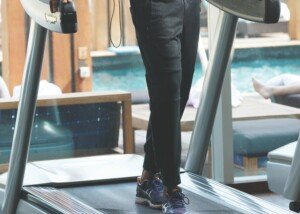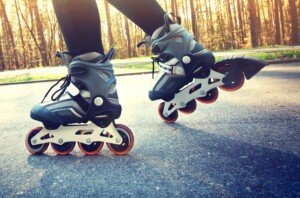
If you’re plus size, don’t begin inline skating ‘til you read these complete guidelines.
Inline skating can be so very fun for overweight or plus size women and men!
I’ve been inline skating for years, and even though I’m not overweight, I can offer the plus size wannabe inline skater some excellent guidelines for getting safely started with this fun form of exercise.
Best Defense Against Falling While Inline Skating
What makes someone fall backwards while inline skating is standing too straight.
A weight shift that causes the body to break past vertical, in a backwards direction, will result in a fall.
The more upright or erect the person is, the more likely a fall will occur. So the best prevention for averting a fall is to strength train the muscles that enable you to maintain a squat position with a forward lean of your trunk.
Think speed skaters at the Olympics. Ever notice how their trunks are virtually parallel to the ice?
Of course, this reduces drag, but it also prevents a backward fall. And yes, Olympic speed skaters fall, but not the same way that a recreational inline skater at the park or on a street falls.
Speed skaters in competition fall (which is almost always forward) due to miss-steps while making a turn, making contact with another skater or skating over something on the ice.
The recreational inline skater falls backwards because, quite simply, they were in a very inefficient position: erect, completely upright.
Now, skating over something on the ground, or over a pit in the ground, can make you pitch forward and fall on your face.
This problem is solved by watching carefully where you’re skating. A small ridge or deviation in the road could cause a forward tumble.
But to really reduce the likelihood of a fall, you must maintain a quarter squat, even third squat, position, with a forward lean of your trunk.
This positioning will very quickly fatigue your lower back and quadriceps muscles—unless you have these muscles trained with resistance.
Exercises for Plus Size Inline Skaters to Prevent Falls
• Squats
• Leg presses
• Leg extensions
• Seated rows
• Kettlebell Swings
• Bent-over Barbell Rows
You’re probably thinking, “What? That’s a LOT of exercises just to enjoy some inline skating!”
However, ask yourself what you hope to accomplish with inline skating other than having fun. I’m betting you’re also anticipating that this will be a good form of exercise.
So think of the six strength training exercises (pictured below) as an adjunct to your overall fitness program, and think of them as key exercises for the backward fall prevention.
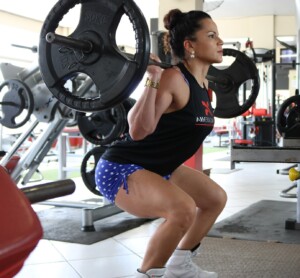
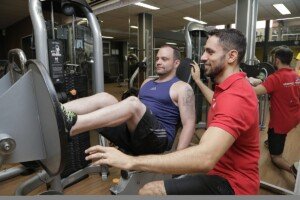
Rafaelqcn, CreativeCommons
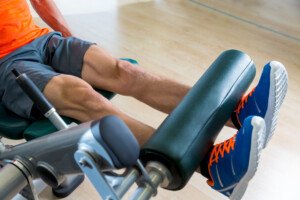
Shutterstock/lunamarina
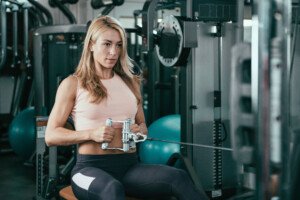
Shutterstock/Microgen
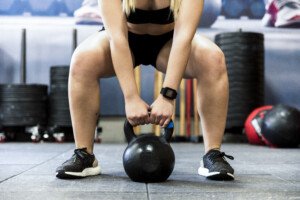
Freepik.com
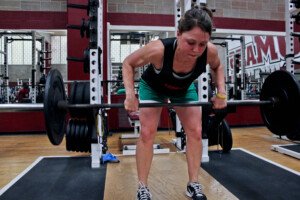
embhoo. CreativeCommons
A fall backwards can severely injure you.
The six exercises can easily be done by plus sized or overweight people. If you’re already doing most of these with correct form and with an intensity range that’s very challenging, you already have some stamina built up in your body to maintain the proper position for inline skating.
But the more intense or burning you make these exercises, the longer you’ll be able to maintain the squat and forward lean when skating.
In fact, with enough fitness built up in your core and legs, you’ll be able to effortlessly sustain this anti-backward-fall position: no aching or very little aching, no burning in the quads or lower back.
It’s simple: If your quads and lower back are used to the burning of a challenging strength training program, then simply holding the partial squat and trunk flexion position when skating will be a breeze — even if you’re plus size.
In addition to all that, sign up for a beginner’s course. That’s what I did, and I learned how to stop while coasting down a hill.
Do not feel self-conscious of your plus size or overweight body while inline skating. I’d love to see a heavy-set person engaging in this activity, but it hasn’t yet happened.
This doesn’t mean it’s not possible. One of my personal-training clients was quite heavy-set and told me she loved to inline skate — up and down hills.
 Lorra Garrick is a former personal trainer certified through the American Council on Exercise. At Bally Total Fitness she trained women and men of all ages for fat loss, muscle building, fitness and improved health.
Lorra Garrick is a former personal trainer certified through the American Council on Exercise. At Bally Total Fitness she trained women and men of all ages for fat loss, muscle building, fitness and improved health.
.

